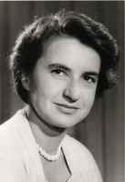Rosalind Franklin
Rosalind Franklin was born in London in 1920. A molecular biologist, her research was critical to the discovery work that led  to the understanding of the structure of DNA. She was one of the most influential female scientists of the 20th century. She died in 1958 after complications with ovarian cancer.
to the understanding of the structure of DNA. She was one of the most influential female scientists of the 20th century. She died in 1958 after complications with ovarian cancer.
Education and Early Career
Franklin attended the girls’ school, St. Paul’s, in London. In 1928, she went to All-Women Colleges , Cambridge. She passed her finals in 1941, but was only awarded a degree titular, as women were not entitled to degrees from Cambridge at the time. She held a graduate fellowship for a year, but quit in 1942 to work at the British Coal Utilization Research Association, where she made fundamental studies of carbon and graphite microstructures. This work was the basis of her doctorate in physical chemistry, which she earned from Cambridge University in 1945.
After the war ended Franklin accepted an offer to work in Paris with Jacques Mering. She learned x-ray diffraction techniques on coal and related inorganic materials during her three years at the Laboratoire central des services chimiques de l’État, but she never fully trained as a crystallographer working on organic chemicals. She earned an international reputation based on her published research on the structure of coal.
Contribution to the discovery of DNA
In 1951, Franklin returned to England as a research associate in John Randall’s laboratory at King’s College, London. It was during this period that she began to collaborate with Maurice Wilkins on DNA projects. Franklin had discovered that DNA could crystallize into two different forms, an A form and a B form. John Randall gave Franklin the A form and Wilkins the B form, assigning them each the task of elucidating their molecular structure. After discovering the existence of the A and B forms of DNA, Rosalind Franklin also succeeded in developing an ingenious and laborious method to separate the two forms, providing the first DNA crystals pure enough to yield interpretable diffraction patterns. She then went on to obtain excellent X-ray diffraction patterns of crystalline B-form DNA and, using a combination of crystallographic theory and chemical reasoning, discovered important basic facts about its structure. She discovered that the sugar-phosphate backbone of DNA lies on the outside of the molecule, not the inside as was previously thought. She discovered the helical structure of DNA has two strands, not three as proposed in competing theories.
The relationship between them would be discovered later by Watson and Crick. She was beaten to publication by Crick and Watson in part because of the friction between Wilkins and herself. At one point, Wilkins showed Watson one of Franklin’s crystallographic portraits of DNA.
Her data, according to Francis Crick, were “the data we actually used” to formulate Crick and Watson’s 1953 hypothesis regarding the structure of DNA. However, it was not until Watson wrote his personal account, The Double Helix, that researchers began to study Franklin’s contribution and the relationship with Watson and Crick’s work.
Nobel Prize
The rules of the Nobel Prize forbid posthumous nominations and because Rosalind Franklin had died in 1958 she was not eligible for nomination to the Nobel Prize subsequently awarded to Crick, Watson, and Wilkins in 1962.
See Also
- Women in Science
- Female Nobel Prize Laureates
Sources
- http://en.wikipedia.org/wiki/Rosalind_Franklin
- http://www.accessexcellence.org/RC/AB/BC/Rosalind_Franklin.php
- http://www.pbs.org/wgbh/aso/databank/entries/bofran.html
- http://www.sdsc.edu/ScienceWomen/franklin.html


